Note: contact me here, or at https://www.facebook.com/cohanseeds/ for seed requests and availability; I usually get seed of most of the Potentillas.
Originally named for P. reptans/ Creeping Cinquefoil a European species, which has long been a commonly used edible and medicinal herb, thus considered 'potens' in Latin (strong, mighty etc, potent; there are other theories about the name, relating to other related or similar looking plants, and their names in Latin and other ancient languages). The other name commonly used for plants in the genus is Cinquefoil, meaning five leaves, referring to their typically compound leaves, which can, however, have from three to fifteen or more leaflets, depending on species. Various other species have been used for food, medicine (astringents and anti-inflammatories, in particular) and tea, so the potent name applies to many! They are also sometimes called Barren Strawberries (also used for related plants, such as Waldsteinia), due to the similarity, but without the juicy fruit!
People who have seen my garden photos and lists of seed efforts will know I am a little obsessed with this genus in the Rosaceae/ Rose Family, growing a number of native and exotic species, with seedlings of several more added in the last couple of years still awaiting flowering. There are -depending on opinion and ongoing research- over 300 to over 500 species, with many being moved in and out of other closely related genera. Closely related plants include Fragaria/Strawberries, Geum/Avens, Rosa/Roses, Agrimonia/Agrimony and Alchemilla/Lady's Mantle, etc.
Plants which have been moved out of the genus by some authorities include Argentina/Silverweed, Comarum/Marsh Cinquefoils etc, Drymocallis, Sibbaldiopsis etc. Ironically, the plants in the genus most commonly known to many gardeners, the Shrubby Cinquefoils or simply Potentilla, have been moved into the genus Dasiphora. Dasiphora are generally low growing shrubs (depending on variety and site) native to a wide swathe of the Northern Hemisphere, and there are a few spots within 10 miles of me where they grow wild, generally open dryish sites, and they become much more common into the foothills and mountains, growing in some very harsh locations. Most gardeners have newer cultivars/hybrids which have a range of flower colours beyond the original bright yellow, and tend to be more compact and leafy than the wild plants. I have one, probably quite old bush, planted by my mom or aunt, it is about 4 feet tall, and more open than the newer forms (though it is a somewhat sheltered spot), flowers from mid-summer until serious frost. I also have a couple of small plants bought cheap at end of season several years ago, with white and creamy flowers. There must be something about their spot they are not wild about, as growth has been very slow, and flowering rather underwhelming.
Local species: Comarum palustre, the Marsh Cinquefoil, shown above in flower, with its unusual dark wine colour, logically found in wetlands and quite common here ( I mean to try it in the garden, where I expect it will not need especially wet soil, just space for its sprawly stems). We also have the weedy P. norvegica/ Rough Cinquefoil, annual or short-lived perennial occurring in a wide range of habitats from wet to dry, including in garden beds of all sorts; when it is not overgrowing small plants, I often leave a few, as they produce quite a lot of biomass to be returned to the soil, for no effort, and not exactly showy, but not unpleasant! Finally, P. gracilis/Slender Cinquefoil; I've only seen it in a few spots (though it is the sort of plant you'd need to be reasonably close to to spot, especially out of flower)-luckily one of those spots is just outside the acreage, and I was able to move a chunk into the garden in a rather natural spot where it has done well. It forms a low mound of attractive leaves backed with whitish hairy backs, from which 30-50 cm or so weakly erect flower stems rise in early-mid summer.
Another Alberta species, though not quite local, is P. pulcherrima (I received seed for these as P. hippiana, and have shared some as such, but that seems incorrect; see also first photo at top of page). Closely related to P. gracilis, and sometimes considered a subspecies, it is similar but a bit more robust in all parts- more and larger leaves, more flowering stems, more erect etc (note: much depends on siting for these as most plants, and they can be taller in gardens than they would in the wild, depending on soil, moisture etc). where I have them planted they grow to 50/60cm at a guess, though I've planted a couple in a much drier spot, we'll see what they do!
Exotic Species: one of the first Potentillas I grew, back in my teen years, was one I collected as a wildflower in the interior of B.C. on a family trip: P. recta/ Sulphur Cinquefoil (for the large, paler yellow flowers, distinct from the many species with bright yellow). When I moved away after high school, the plant survived decades of inattention to my old rock gardens as seed in the soil, and sprouted after I started reworking them. Ironically, as I realised when looking into it after moving back, it is actually a Eurasian plant, and an invasive weed in B.C. It makes the warning lists in Alberta, but the threat here is potential, not actual. So I dutifully pulled up my plants, but an occasional seedling still appears, I'm debating whether to let one come to flower again... It has been years since any were allowed to, so, I only came up with one old shot..
Of less concern re: escape is P. nepalensis/ Nepal Cinquefoil and its varieties_ I've grown Miss Willmott with orangey coral flowers with a red centre, and Ron McBeath, deep pink with darker centres; there are several other variants on those colours. I don't think I've found quite the right spot for these (indeed, I need to go out and make sure I have not lost one or more of them)-- Miss Willmott I had in a partly shaded, woodland edge sort of bed, it grew well but was very floppy (not sure that can be totally avoided)-- I think a bit more sun and or leaner soil might help, but best is perhaps to have them with other strong stemmed plants or small shrubs that they can sprawl on/through. Ron McBeath was in a tougher bed with Achilleas and Veronica, but there it may have been overwhelmed! I sowed the somewhat similar Potentilla atrosanguinea / Himalayan Cinquefoil and (separate species or variety of the previous depending on source) P. argyrophylla/ Silver-leafed Cinquefoil last year, I think only the latter germinated; they are making nice silvery leaves, and I'm waiting to see whether the flowers will be scarlet or orangey with a darker centre, I want both!
Also silvery of foliage, though with much less showy flowers, is P. valderia/ Valdieri's Potentilla. This rather uncommon species from alpine France and Italy is underwhelming in flower, as seen below, but the fuzzy white leaves (variable from seed, I have some that are greener; in this shot they are spotty from a rain shower that just passed) are always nice in a lowish mound. Flowers shown with the Asian Saussurea cf S. iodostegia with nearly black flowers. Native bees seem unbothered by the inconspicuous flowers, and visit them enthusiastically.
So far I've shown plants that are medium/larger size (P. valderia is at the smaller end of that group, maybe 30cm or a bit more in flower, I grow then at edges of rock gardens or on berms), but there are many lower growing species suited to rock gardens or troughs. I just have a few, a couple more as seedlings, and more on the endless wish lists! P. nitida/ Bright Cinquefoil is a choice plant from the Alps, forming (possibly quite large if happy) low mats of silvery foliage; plants from seed will show some variation in leaf colour and form, and number of flowers produced. In some places, they may flower little. I've had some plants flower decently, others scarcely, I've also had plants die back in some beds, not in others-- they seem happiest with quite lean/rocky/thin soil (though mine can probably reach roots down to moisture if they want)-- and keep in mind I do not have a hot summer climate. Flowers can be white to barely pink to a good pink (forma rubra) mine are somewhere in the middle of that. One plant has flowered very well this year, not sure if it is weather, age or the fact I've had water trickling in the bed at times to discourage ants! Uncommonly for the genus (the few species that I know) seeds are encased in fluff.
Another nice rock garden species is P. pulvinata/ Cushion Potentilla; this Turkish plant has nice greyish/fuzzy leaves which have nice subtle fall colour. Foliage forms a low mound in spring, from which rise flower stems initially flowering right at leaf level, then elongating to 20-30cm (I'd like to grow some species that stay more or less flat, but this is nice, too!). A couple of plants I have are in very thin/rocky soil, and they stay noticeably smaller, but that also means fewer flowers!
I've added another three to four species in the last two seed sowing seasons, so follow me here and on Facebook to see what's coming! Remember there are over 300 species....
 |
| Potentilla pulcherrima; good native for meadow/xeric gardens; Alberta seed, Gaillardia behind |
 |
| Comarum palustre/ Marsh Cinquefoil, moved out of Potentilla; wild in Alberta |
People who have seen my garden photos and lists of seed efforts will know I am a little obsessed with this genus in the Rosaceae/ Rose Family, growing a number of native and exotic species, with seedlings of several more added in the last couple of years still awaiting flowering. There are -depending on opinion and ongoing research- over 300 to over 500 species, with many being moved in and out of other closely related genera. Closely related plants include Fragaria/Strawberries, Geum/Avens, Rosa/Roses, Agrimonia/Agrimony and Alchemilla/Lady's Mantle, etc.
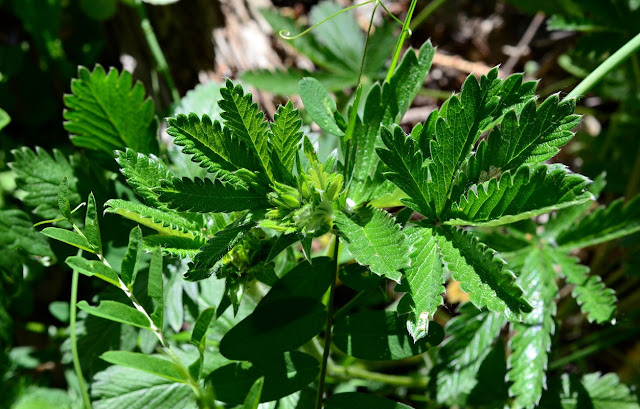 |
| Potentilla gracilis/Slender Cinquefoil; as much as the rose-like flowers, the foliage of the genus shows its affinity with cousins like Avens, Strawberries, Roses, etc |
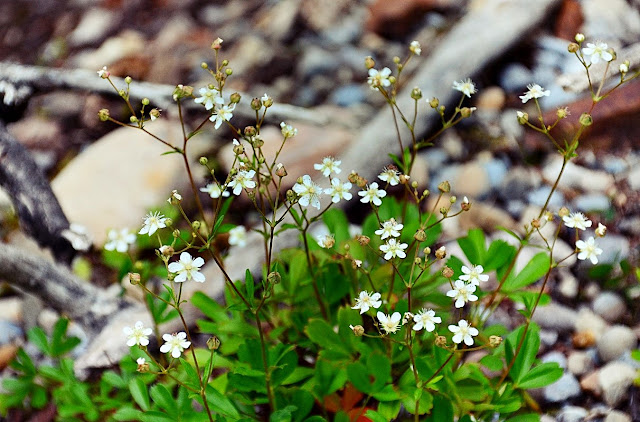 |
| Sibbaldiopsis tridentata/ Three-toothed Cinquefoil in the Garden; no longer in Potentilla, still great garden potential, small spreading rhizomatous plant, great fall colour too and long flowering |
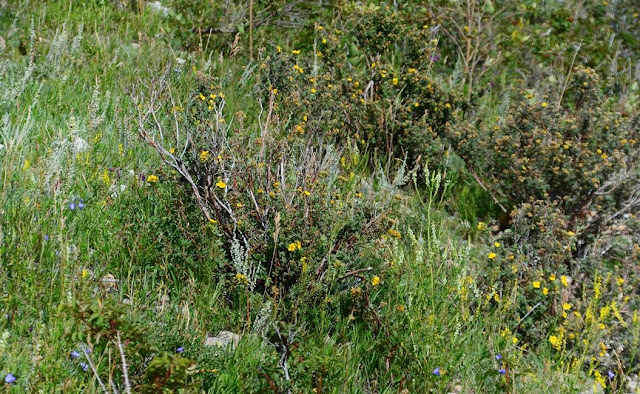 |
| Dasiphora fruticosa/ Shrubby Cinquefoil, with Sagewort, Harebells etc Abraham Lake, Alberta |
 |
| Dasiphora fruticosa/ Shrubby Cinquefoil, Old Cultivar, in October, flowering after frosts, Alberta |
 |
| Dasiphora fruticosa/ Shrubby Cinquefoil, Newer Cultivar, After Frost, Alberta |
 |
| Comarum palustre/Marsh Cinquefoil, wild, showing great fall colour like many Rosaceae |
 |
| Potentilla gracilis/ Slender Cinquefoil, wild, just outside the driveway |
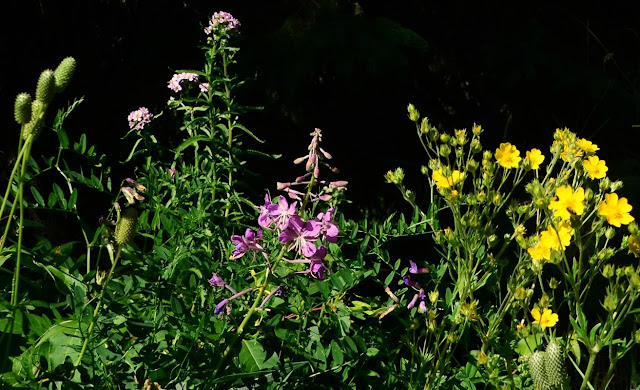 |
| Potentilla gracilis/ Slender Cinquefoil, in a half wild spot in the garden, with native Fireweed, Anemone, Vetch and garden Achillea/Yarrow |
 |
| Potentilla pulcherrima/ Beautiful cinquefoil, in the garden; a fairly tall and erect species, lots of modest sized flowers |
Exotic Species: one of the first Potentillas I grew, back in my teen years, was one I collected as a wildflower in the interior of B.C. on a family trip: P. recta/ Sulphur Cinquefoil (for the large, paler yellow flowers, distinct from the many species with bright yellow). When I moved away after high school, the plant survived decades of inattention to my old rock gardens as seed in the soil, and sprouted after I started reworking them. Ironically, as I realised when looking into it after moving back, it is actually a Eurasian plant, and an invasive weed in B.C. It makes the warning lists in Alberta, but the threat here is potential, not actual. So I dutifully pulled up my plants, but an occasional seedling still appears, I'm debating whether to let one come to flower again... It has been years since any were allowed to, so, I only came up with one old shot..
 |
| Potentilla recta/ Sulphur Cinquefoil, potential invasive weed, in the garden Alberta |
 |
| Potentilla nepalensis "Miss Willmott" |
 |
| Potentilla nepalensis "Ron McBeath" |
 |
| Potentilla valderia/ Valdieri's Potentilla with Saussurea cf S. iodostegia |
So far I've shown plants that are medium/larger size (P. valderia is at the smaller end of that group, maybe 30cm or a bit more in flower, I grow then at edges of rock gardens or on berms), but there are many lower growing species suited to rock gardens or troughs. I just have a few, a couple more as seedlings, and more on the endless wish lists! P. nitida/ Bright Cinquefoil is a choice plant from the Alps, forming (possibly quite large if happy) low mats of silvery foliage; plants from seed will show some variation in leaf colour and form, and number of flowers produced. In some places, they may flower little. I've had some plants flower decently, others scarcely, I've also had plants die back in some beds, not in others-- they seem happiest with quite lean/rocky/thin soil (though mine can probably reach roots down to moisture if they want)-- and keep in mind I do not have a hot summer climate. Flowers can be white to barely pink to a good pink (forma rubra) mine are somewhere in the middle of that. One plant has flowered very well this year, not sure if it is weather, age or the fact I've had water trickling in the bed at times to discourage ants! Uncommonly for the genus (the few species that I know) seeds are encased in fluff.
 |
| Potentilla nitida/ Bright Cinquefoil-neither the pinkest, nor whitest nor flattest form! |
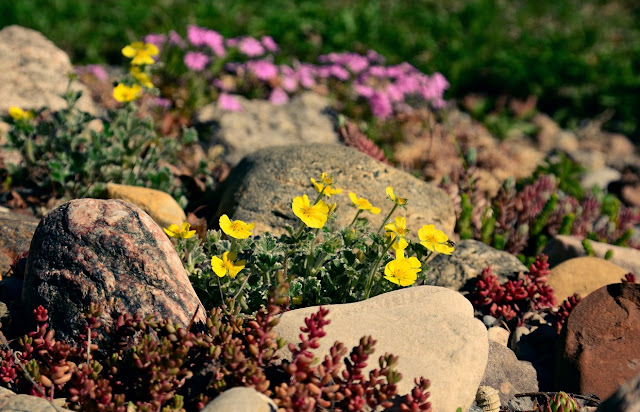 |
| Potentilla pulvinaris /Couch Cinquefoil- early flowers, close to plant, thin soil site |
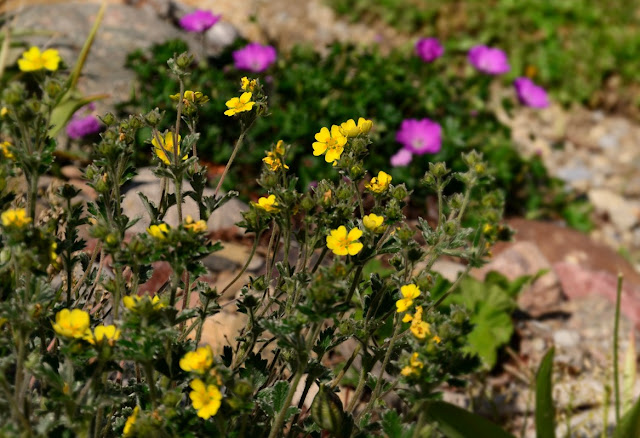 |
| Potentilla pulvinaris / Couch Cinquefoil, later flowers, elongated stems, in a slightly deeper soil than previous photo. |
Comments
Post a Comment